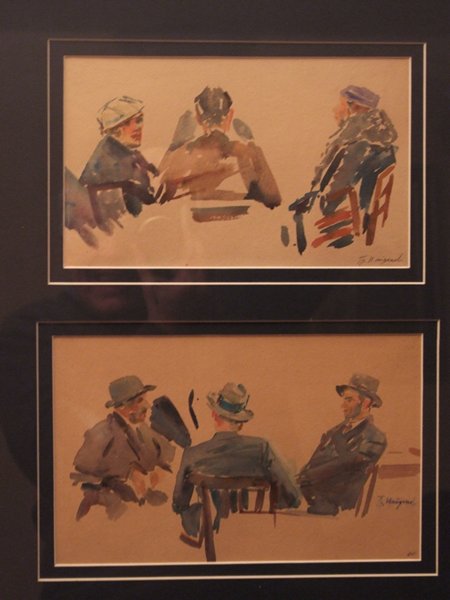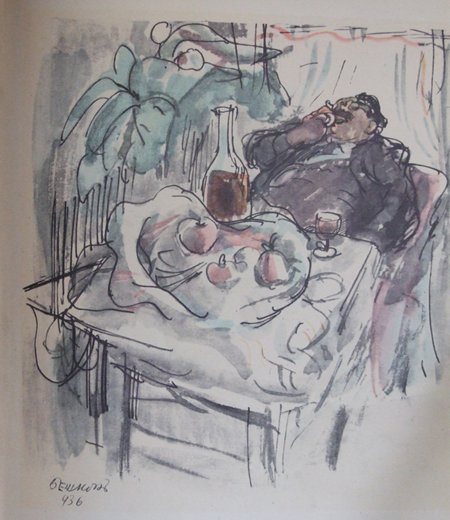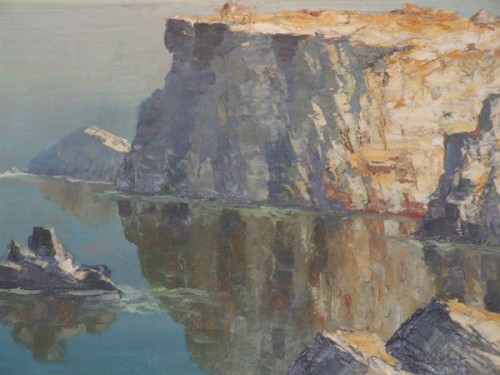15th October 2014 Sofia, Bulgaria
Painting as a Way to Understand a Country's Soul
by Ronald Young
Ronald Young left Britain in 1991 and since then he has been on the move – first in Central Europe and then from 1999 in Central Asia and Caucusus. After working on various projects in China, Bulgaria and Romania, now Ronald shares his time between an old house in the Carpathian Mountains and Sofia. In the meantime, he has also discovered the Bulgarian painting tradition and became an art collector. Ronald runs a blog that helps him make sense of his organisational endeavours and his love for painting in the 20th century realist schools of Bulgaria and Belgium.
“Sofia is my favourite European city – it has the liveable atmosphere which has disappeared in other capitals – with great parks, restaurants, galleries and public transport – and few high-rise buildings in its centre.” – Ronald Young
I’m a bit of a nomad – out of the UK since 1991 and living in a dozen countries since then. I counted recently and came up with 35 addresses which I’ve had. We Scots have a term for this – “no fixed abode” or NFA – a term which I first came across during my stint in the 1970s as a magistrate (or “Bailie” as we called it) in a shipbuilding town over whose lower court I would preside on Monday mornings – as miscreants came up from the cells to answer for their various misdeeds. Amazing how many of them were NFA – but I didn’t realise then that I would join their ranks a few decades later!
I had a memorable May Day in 1991 in Sofia – representing the World Health Organisation but not realising the date – and given therefore the chance to scale Vitosha with a young lady from the Ministry of Health! But it was to be 2007 before I had the chance to live here – thanks to the EC procurement systems which attached me first to the Institute of Public Administration and then (under Structural Funds) to a couple of private companies who were training municipal officials.
Sofia is my favourite European city – it has the liveable atmosphere which has disappeared in other capitals – with great parks, restaurants, galleries and public transport – and few high-rise buildings in its centre (!). I love nothing so much as a brisk morning walk to the pool/fitness; a weekend cycle; browsing in one of the great vegetable markets or second-hand bookshops; a chat with my gallery friends; often livened by a shot of Kalyshka Rakia… and a lazy dinner with a superb Bulgarian wine.
I also have a mountain house in the Romanian Carpathians and therefore have a term of comparison – which strengthens my conviction that Bulgaria has something very special to offer the visitor.
Both countries have superb landscapes – and they are both proud peoples. Somehow, the Bulgarian pride is simpler. Since Winston Churchill’s put-down in the late 1940s of the Leader of the Labour Party – “a modest man – he has a lot to be modest about”, I hesitate to use that adjective. But that is part of the attraction of the Bulgarians – they are not pretentious and have not spoiled their country.
What I quickly fell in love with here in Bulgaria were the paintings of their land- and sea- scape artists. Shortly after, I came across a book written in 1932 by the Balkans’ correspondent for the Christian Science Monitor – Meet Bulgaria –which has delightful photos and can be read in its entirety in the link. This is what RH Markham had to say – all of 82 years ago:
“Very recently a prominent Bulgarian assured me that water colors by the leading Bulgarian artists are second to none in Europe and when I showed some reluctance in accepting so sweeping a judgment, my interlocutor “guaranteed” me that his statement was perfectly accurate and offered to prove it by comparing the best Bulgarian paintings one by one with the best of the contemporary European masters. Being unacquainted with the European masters I accepted the guarantee on faith, though even yet I am a bit doubtful.
Nevertheless, I was very much impressed by the fact that a lawyer, who had given much of his life to politics and was at that moment engaged in trying to improve Bulgarian agriculture, should be so much interested in art”.
I too have found the Bulgarian painting tradition beautiful – and indeed found myself becoming an art collector here! Of not only 100 works of the older school but of various young contemporaries whom I also admire – such as Yuliana Sotirova, Milcho Kostadinov, Atanas Matsoureff and the wonderfully creative and amusing Angela Minkova.
Bulgarian painters generally (let alone of this particular period) are not well known abroad. Hardly surprising when no book exists (or seems ever to have been published) about Bulgarian painting in the English language The incredible Posada art bookshop in Brussels had Europe’s largest collection of artbooks and, in 2010, I could find (and buy) only one book about Bulgarian art – as it happens a lovely 1947 edition of Art Moderne Bulgare (French) published by the (then) new Ministry of Culture.
So, in 2012, I published a small book subtitled Getting to know the Bulgarians through their paintings which I hope, in its own small way, will help change that perception. It started quite simply from a few pencilled lists from the friends I quickly made in the small galleries which are such a lovely feature of Sofia’s so friendly and walkable centre and aims to introduce “modern realist” Bulgarian painting to visitors and to encourage them to spend time (and perhaps some money) browsing the galleries here.
It is written by a complete amateur – I have no art training or skills but have always put a visit to the municipal art gallery at the top of my list when visiting the various cities of Europe (and central Asia). It doesn’t pretend to be a comprehensive guide to the painters who have been active in Bulgaria in the past 100 years – but rather to –
- give a sense of what Bulgarian realist painters offer
- encourage visitors to Bulgaria to visit both the private and municipal art galleries – where you are generally received like royalty; and
- inspire them make their own discoveries and purchases – the emphasis being on the “affordable”
I’ve found it an increasingly fascinating challenge to try to penetrate the soul of a country – in a recent little E-book about Romania, I suggested there were 16 different ways – of which painting is only one. Despite (or perhaps because of?) its size, it seems more difficult to penetrate than its larger (and still estranged) neighbour to the north but painting is still, I have discovered, a good route to use to explore its interior… Remarkably, its artists had only some 60 years of freedom before they were faced from 1944 with the diktats of communist rulers and, even today, art history in the country is shaped by figures who had power in that 45 year period. I have a growing library of art books both from that period and contemporary – and the silences and gaps in the coverage speak volumes.
Bulgarian caricaturists of the first half of the 20th century were amongst the world’s best – names such as Ilyia Beshkov, Marco Behar, Stoiyan Venev and Boris Angeloushev – many of them good left-wingers in the 1930s who found themselves in positions of authority a decade later. I would love to have witnessed a conversation between Beshkov, for example, and artists such as Boris Denev, Constantin Shterkelov and Nikolai Boiadjiev who were forbidden from painting. There is still all too little written (even in Bulgarian) about this period of the country’s life…
All the better, therefore, to see this book of superb black and white photographs of the period (including delightful shots of Nikola Tanev) edited by Bulgaria’s best photographer Ivo Hadzhimishev.
Sofia has an old-fashioned gentility – mainly from the tiny shop and gallery units of its centre with both young and old eking out a fragile existence but at least one whose rhythm they control.
With its parks and buskers with their retro music; narrow streets, small shops and atmosphere, the owners on the doorstep with a coffee and cigarette talking with friends, Sofia should be one of the pin-ups of the slow food movement.
The modest grid-iron system which is its centre developed after the 2nd WW bombing; has kept cars in their place; and created small spaces which old and young alike have been able to use to pursue their dreams – whether shops where they sell the clothes they design themselves, micro art galleries, tobacco, wine cellars.
Of course the downside of such charm is that those who run the tiny vegetable, dressmaker, thread, tobacco shops and various types of galleries are just eking out a living. But the spirit they represent is priceless – and deserves more support.
P.S. The included photos of paintings have been kindly provided by Ronald Young.



yeah it makes oyher cultures to be identified in the outter